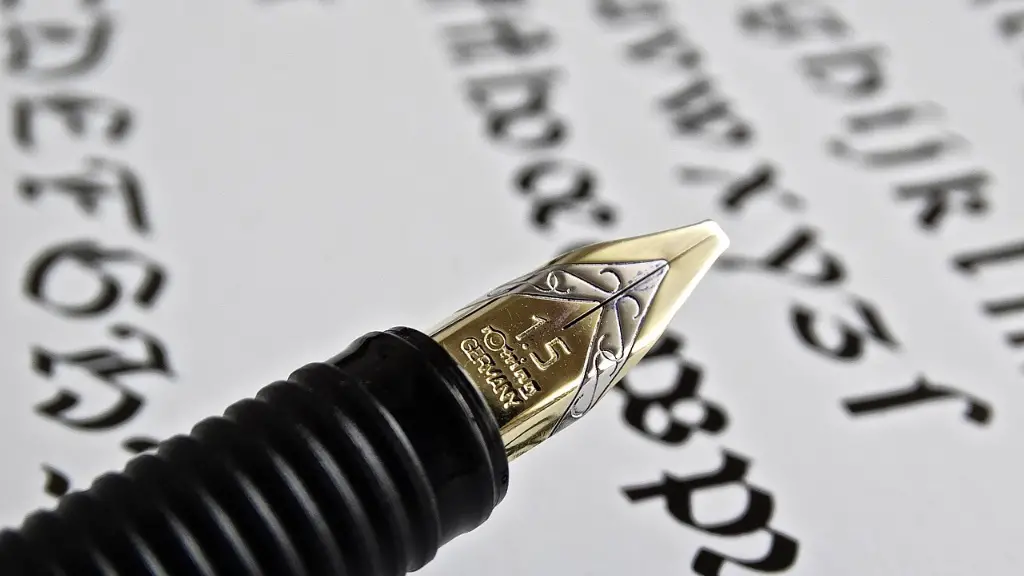What is an Idiom
An idiom is a phrase or expression which has a figurative, or sometimes literal, meaning. Idioms are generally used to express a particular emotion or point of view, and are frequently used in everyday conversation or in literature. Idioms can be used to add emotional depth and artistic flair to a poem or a story. An idiom can be used to communicate a complex idea quickly and accurately.
Idioms are part of the language’s figurative stock – they provide important ways to express emotions, opinions and to give a more vivid description to a narrative. Idioms have been used in prose, poetry, music and other forms of art to provide a unique layer of meaning to a work. For example, “It was raining cats and dogs” is an idiom which, when used in a poem, can evoke an image of a chaotic and tumultuous scene.
The Uses of Idioms in Poetry
Idioms are a powerful tool for poets to use in their work. They can be used to express a sentiment or evoke an emotion, and can add depth and richness to the poet’s language. Idioms can be used to create a sense of familiarity with the reader, as some idioms are widely used and easily understood in conversation. They can also add a layer of mystery and ambiguity, as some idioms can be interpreted in various ways.
Idioms can be used to create vivid imagery and focus the reader’s attention to a particular point. An idiom can bring a phrase to life, allowing the reader to interpret the poem in a more detailed and personal way. For example, “Before the sun kissed the sky” is an idiom which a poet can use to evoke the colorful imagery of a beautiful sunrise.
Idioms can also be used to create a sense of tone or mood in the poem. An idiom such as “Through thick and thin” can create a tone of loyalty, while an idiom such as “Head in the sand” can create a tone of being oblivious to the world.
Idioms can also be used to create a sense of irony or sarcasm in a poem. An idiom such as “A drop in the ocean” can create a sense of the seemingly insignificant amount of effort that was put forth, and can be used to highlight a false sense of grandeur in a particular situation.
Idioms can also be used to bring a sense of emotion, authenticity, and immediacy to a poem. An idiom such as “Fly by the seat of your pants” can be used to create a sense of excitement or adventure, while an idiom such as “Break a leg” can be used to create a sense of encouragement.
The Art of Selecting Idioms
The art of selecting idioms is a skill that must be developed by the poet in order to successfully use them in their work. A poet must consider the different nuances of an idiom and how it can best be used to amplify the mood, emotion, or point of view they are trying to express.
A poet must also ensure that they are selecting a phrase that accurately expresses their sentiment without losing the meaning of the poem. When selecting an idiom, it is important to consider how it will be interpreted by the reader and to be sure that it is appropriate for the context in which it is being used.
Selecting the right idiom for a given poem or situation can take some practice, but it is worth the effort. With the right phrase, a poet can evoke an emotional reaction, add depth and complexity, and convey a larger message to their readers.
What Idiomatic Poetry Can Do
Idiomatic poetry can evoke strong emotional reactions from readers and can be used to illustrate complex ideas in an effective and efficient way. Idiomatic poetry can create vivid imagery, evoke powerful messages, and add a unique layer of meaning to any work.
Idioms can also add a unique element of surprise to a poem, as readers can be guided in unexpected passages and make their own interpretations. Each reader may take away a different message from an idiom-filled poem, allowing for a more immediate and personal reading experience.
The use of idioms in poetry can also set a strong tone and mood for the poem, making it easier for the reader to relate to the message of the poem. By looking at the context of a phrase and its implications, a reader can gain a better understanding of its intended message as well as the overall tone of the poem.
The use of idioms in poetry can help to engage readers and can be used to evoke powerful and unique emotions and images. Idioms are an essential part of a language, and using them correctly in poetry can produce powerful results.
The Impact of Idiomatic Poetry
The impact of idiomatic poetry is undeniable. From evoking powerful emotions, to conveying complex ideas in a creative and effective way, idiomatic poetry can bring a unique and powerful intensity to any poem.
Idiomatic poetry can help readers gain a deeper understanding of the poem and the poet’s original intent. With the correct use of idioms, a poet can convey their message in a powerful and effective way.
Using idioms in poetry can also foster a more engaging reading experience for readers. With the right idiom, readers may find themselves unexpectedly taken on an emotional journey, as the words on the page come to life with deeper and more personal meanings.
Ultimately, using idioms in poetry can be a powerful tool for writers and poets. Whether they are used to evoke emotion, to convey a complex idea, or to illustrate a scene, the use of idioms can help to create a powerful and unique poem.
Intertextuality of Idiomatic Poetry
Idiomatic poetry can help to create a unique intertextual experience for readers. By using idioms, a poet can draw in allusions to other works, creating an experience of shared, broader meanings for the poem.
Idiomatic poetry can also be used to link multiple works together. By carefully selecting an idiom, a poet can draw on the meanings, connotations, and implications of other texts. This can be used to create an intertextual experience for readers and to help convey a deeper meaning to the poem.
Idiomatic poetry is also a great way to express powerful, complex emotions. Many idioms are loaded with potential meanings, allowing the poet to express their feelings in a creative and meaningful way.
Idiomatic poetry can also help to create a sense of identity for the poet. By carefully choosing idioms and incorporating them into their work, a poet can form a unique and personal style that speaks to the world around them.
The Power of Idiomatic Poetry
Idiomatic poetry is an incredibly powerful creative tool. By carefully selecting idioms and utilizing them properly, a poet can create works of art that resonate with readers on a personal and emotional level. Idiomatic poetry can evoke powerful images, amplify emotions, and convey complex ideas in a creative and efficient way.
Idiomatic poetry can also provide a unique level of engagement with readers. By using carefully selected idioms, a poet can draw readers into their own unique world and evoke powerful reactions in the process.
When used correctly, idioms can provide a unique level of engagement and emotion in a poem. By using them in their work, poets can create works of art that speak to their audience and make a lasting impression.





